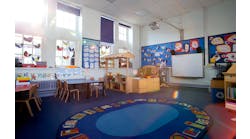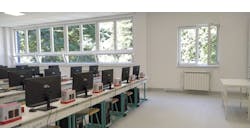Schools and universities that have not upgraded their windows in many years will find that there are new systems available to help conserve energy and cut down on building heating and cooling loads.
The Collaborative for High Performance Schools recommends that institutions install double-paned windows with low-emissivity (low-e) coatings. Low-e coatings on glazing can reduce the heat or cold that enters a learning space. The coatings also reduce glare while allowing students and teachers views to the outside.
Having windows with double-glazing reduces the heat transmittance even more. If the space between the two layers of glazing is filled with argon, krypton or a similar gas that is less conductive than air, the heat transfer will be even less.
The Efficient Windows Collaborative says that when using argon as a gas fill in a double-paned window, the optimal spacing between layers of glazing is about half an inch. Krypton is more expensive, but often is used when the space between the layers of glazing must be thinner than normally desired. The optimal gap width when using krypton is ⅜ths of an inch, the Windows Collaborative says.
The National Fenestration Rating Council (NFRC) has established a system to determine the energy performance of window systems and compare products with one another.
The NFRC says its energy performance label “can help you determine how well a product will perform the functions of helping to cool your building in the summer, warm your building in the winter, keep out wind, and resist condensation.”
The data found on the NFRC label:
-
U-factor measures how well a window system prevents heat from escaping. U-factor ratings generally fall between 0.20 and 1.20. The lower the U-value, the greater a window's resistance to heat flow and the better its insulating value.
-
Solar Heat Gain Coefficient (SHGC), expressed as a number between 0 and 1, measures how well a window system blocks heat caused by sunlight. The lower a window's solar heat gain coefficient, the less solar heat it transmits into an interior space.
-
Visible Transmittance (VT), also expressed as a number between 0 and 1, measures how much light comes through a window system. Most values are between 0.3 and 0.8. The higher the VT, the more light is transmitted.
Two other ratings are optional, the NFRC says, and manufacturers may choose not to include them:
-
Air Leakage (AL) measures the heat loss and gain that occurs by infiltration through cracks in the window assembly. The lower the AL, the less air will pass through cracks in the window assembly. The council recommends selecting windows with an AL of 0.30 or less.
-
Condensation Resistance (CR), expressed as a number between 0 and 100, measures the ability of a window system to resist the formation of condensation on its interior surface. The higher the CR rating, the better that product is at resisting condensation formation.
The types of windows a school or university chooses also can affect building security. The state of Florida's Safe School Design Guidelines says windows should be situated in a way that deters after-hours access. Windows in administrative areas “enable staff to monitor the main entrance as well as other areas on the school campus,” the guidelines say, and classroom windows enhance surveillance because “many eyes can have views of exterior areas such as parking lots, exterior pedestrian routes, and recreational facilities.”
In addition, the guidelines recommend incorporating view panels and sidelites in classrooms and administration areas along corridors can provide enhanced security. Whenever possible, extensive glazing should be utilized to permit views and surveillance of exterior areas such as courtyards.

